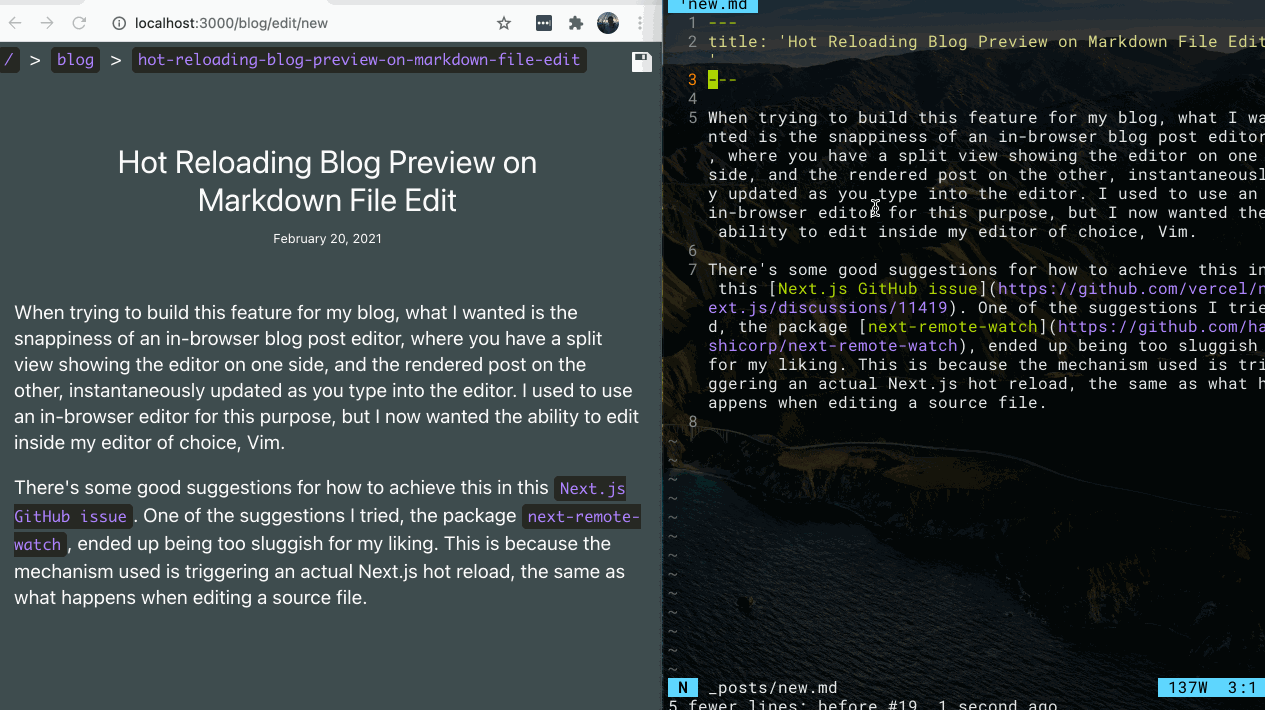With the hype of the Jamstack, and the benefits it offers, I made the switch from MERN stack to JAM stack for my blog. The most appealing benefits to me in my use case were:
Improved SEO, for my site that can be 100% statically generated.
Simplified architecture. No more databases and servers, just files served from GitHub Pages.
Using Git as my "CMS". Switching from storing blog posts in a database, to storing them in
.mdfiles, tracked by Git.
Choosing a React Static Site Generator
Coming from a MERN app, I needed a SSG solution for React. I considered choosing between three different options:
The two most popular React frameworks are Gatsby & Next.js. Gatsby is a very powerful tool that emphasizes a plugin ecosystem. Gatsby can do a lot. As I went through Gatsby's vast documentation, I was having difficulty figuring out how to do what I wanted to do, for my fairly simple use case. After this experience, I was drawn to the simplicity of React Static. Ultimately, I ended up choosing Next.js for a few different reasons, one being their documentation coupled with their collection of examples on GitHub. I used their blog-starter template as a starting point. Another reason I chose Next is their great out-of-the-box TypeScript support.
The last minor thing that sealed the deal for my decision, was the React team announcing that they are collaborating with the Next.js team on React's new experimental feature, "Server Components". Relevant links:
While not a huge factor, it gave me the impression that the design philosophies of Next.js and the React core team align the most closely, and that Next.js would be receiving first-class support for this feature.
Migrating from MERN to JAM
Source code can be found here:
Post-migration GitHub source: https://github.com/zzzachzzz/zzzachzzz.github.io/tree/master
Pre-migration GitHub source: https://github.com/zzzachzzz/zzzachzzz.github.io/tree/2ab6f0b10606162a57b946461c4dae74e2a295d5
Aside from the usual steps to migrate a common React app to a Next.js React app, there were a few other things I needed to handle in the migration. There would be changes to accommodate for the removal of a server; no Express & no MongoDB. There would also be some small changes to account for a React app utilizing SSG or SSR (server-side rendering), specifically the way CSS is loaded, depending on the tool you use for CSS.
MongoDB to .md Files
For moving the content from MongoDB to markdown files, I created a migration script: backend/migrations/db-to-markdown-file.js
CSS for SSG / SSR
Depending on which tool you use for CSS, Next.js documents how to use it in SSG & SSR here: https://nextjs.org/docs/basic-features/built-in-css-support
From there, they link to examples on their GitHub. I use styled-components, so I followed their example here: https://github.com/vercel/next.js/tree/canary/examples/with-styled-components
Hosting a Static Site on GitHub Pages
In addition to the next build script, to deploy a fully static site without a server, the next export script is used: https://nextjs.org/docs/advanced-features/static-html-export
When hosting the static build on a git branch on GitHub Pages, the naming of the exported _next/ directory triggers Jekyll on GitHub Pages, as directories with a leading underscore have a special meaning to Jekyll. This unexpected side effect resulted in 404s for certain static assets my site was trying to fetch. To disable Jekyll processing on GitHub pages, we need to provide a .nojekyll file at the root. This was my final build script in my package.json file:"build": "next build && next export && touch ./out/.nojekyll"
More info here: https://github.blog/2009-12-29-bypassing-jekyll-on-github-pages
While not mandatory, I do recommend the gh-pages npm package if you do intend to deploy to GitHub Pages. By default it will push to a branch named gh-pages. You'll want to configure your GitHub repo's settings to serve GitHub Pages from this branch. In conjunction with the build script I mentioned above, this was my deploy script:"deploy": "yarn run build && gh-pages --dist out --dotfiles"out/ is the default output directory name for a Next.js static export, and we need to include the option --dotfiles for the .nojekyll file to be included in the push to the gh-pages branch.
Getting Prism.js to Work with SSG / SSR
I never found it straightforward to set up Prism.js for code highlighting in a React app. When my pages were still being rendered client-side, I used React.useEffect to trigger Prism to highlight all code blocks:
React.useEffect(() => {
Prism.highlightAll();
}, []);While I could still have the effect be performed client-side, I wanted to go all in on having my site be fully statically generated. In my TreeToJSX.tsx component, responsible for rendering a markdown document tree to JSX, I came up with the following solution to have the Prism highlighted HTML be built:
// Add leading whitespace to <code> className due to className mismatch caused by Prism injecting class
const CodeBlock = ({ lang, children }: { lang?: string; children: string; }) => {
const langCls = ` language-${lang || 'none'}`;
if (lang) {
const highlightedCode = Prism.highlight(children, Prism.languages[lang], lang);
return (
<Pre className={langCls}>
<code className={" " + langCls} dangerouslySetInnerHTML={{__html: highlightedCode}}></code>
</Pre>
);
} else {
return (
<Pre className={langCls}>
<code className={" " + langCls}>{children}</code>
</Pre>
);
}
};Prism offers a low level highlight function that will return stringified HTML of the syntax highlighted code we provide in the string children. I was getting a warning about a mismatching className between the client and server (server in development, for SSG). The mismatch was caused by leading whitespace in one but not the other: " language-jsx" vs "language-jsx". This was some oddity caused by the way Prism injects CSS classes, that I was able to workaround by adding leading whitespace to the class names.
Hot Reloading a Rendered Blog Post Upon its Markdown File Being Edited
I outline this feature in a separate post:
Hot Reloading Blog Preview on Markdown File Edit
